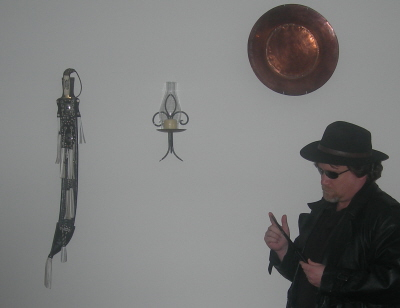|
About This Author
Come closer.
|
Complex Numbers
Complex Numbers
A complex number is expressed in the standard form a + bi, where a and b are real numbers and i is defined by i^2 = -1 (that is, i is the square root of -1). For example, 3 + 2i is a complex number.
The bi term is often referred to as an imaginary number (though this may be misleading, as it is no more "imaginary" than the symbolic abstractions we know as the "real" numbers). Thus, every complex number has a real part, a, and an imaginary part, bi.
Complex numbers are often represented on a graph known as the "complex plane," where the horizontal axis represents the infinity of real numbers, and the vertical axis represents the infinity of imaginary numbers. Thus, each complex number has a unique representation on the complex plane: some closer to real; others, more imaginary. If a = b, the number is equal parts real and imaginary.
Very simple transformations applied to numbers in the complex plane can lead to fractal structures of enormous intricacy and astonishing beauty.
| |
Today's article is from 2020, hence the COVID quarantine angle. But the interesting bits are historical, so feel free to ignore the COVID part just like you're ignoring COVID itself.
Throughout the world, from the humblest abode to the most lavish mansion, our homes have always been a respite from the world.
That is, until recently, when the internet brought the world inside our houses.
When we think of the technology that makes our homebound life bearable, we call to mind those electronic devices that allow us to remain connected to the outside world.
Nah, I think of beer. And modern beds. A few years ago, I sprung for a memory-foam mattress with an adjustable frame so I could sit up to read in it. Worth every penny, and it even came with a remote control. Now that's a fine use of modern technology.
But yeah, the internet has been competing with books, bed, and beer for my attention since the early 90s.
However, it might surprise us to know that, for our ancestors, many of the objects we take for granted, like napkins, forks and mattresses, were also once marvels of comfort and technology—available to only the few.
Well, not that surprising. Things like adjustable beds—or even nice comfortable mattresses—pretty much everything was once a luxury item, until it could be mass-produced enough to be accessible to us peons.
Our temperature-controlled homes filled with comfortable furniture and lights that turn on at the flick of a switch are luxuries unfathomable to the kings and queens of the past.
Yeah, but kings and queens had servants.
Perhaps, like me, you’ll find yourself grateful for our ancestors who suffered with stone or wooden headrests, stiff-backed chairs and cold nights before feather-stuffed pillows and fluffy duvets were part of everyday life (and appreciative of those who imagined that things could be better).
Non-homeless-like typing detected.
In The Elements of a Home: Curious Histories Behind Everyday Household Objects, from Pillows to Forks, I’ve uncovered the stories behind the objects that fill our homes and our lives.
And there it is, folks: the "Buy My Book" portion of the article. Look, the article's free; there's gotta be an ad of some sort. Apparently they're also getting paid by the History Channel (ugh) and of course they want you to subscribe to the magazine. For every great advance in technology and society, there's a price. Today, the price is goddamned ads. (Or, like me, you can install a script blocker. I had to open the article in another browser to see the actual ads.)
I'm not going to quote every section here. Just a few highlights.
The fork was once considered immoral, unhygienic and a tool of the devil.
This should not be surprising. There's a certain segment of the population that considers everything new to be a tool of the devil. It takes a generation or two, at least, for it to become mainstream (see also: Dungeons and Dragons). To be fair, though, a fork literally looks like a tool of the devil.
In 1004, Maria Argyropoulina, niece of the Byzantine emperors Basil II and Constantine VIII, was married to the son of the Doge of Venice.
Much nobility. Wow. 
She brought with her a little case of two-pronged golden forks, which she used at her wedding feast. The Venetians were shocked, and when Maria died three years later of the plague, Saint Peter Damian proclaimed it was God’s punishment. And with that, Saint Peter Damian closed the book on the fork in Europe for the next four hundred years.
Okay, so what about the rest of the world? Europe was hardly the pinnacle of culture at the time.
Keys weren’t always pocket-sized.
Locks as we know them are a surprisingly modern invention. So are the doorknobs they generally inhabit.
However, the ones that opened the wooden locks of the massive marble and bronze doors of the Greek and Egyptians could be three-feet in length, and so heavy that they were commonly carried slung over the shoulder—a fact that is mentioned in the Bible.
I'm thinking Superman's neutronium key to the Fortress of Solitude here.
Ancient Romans, who lived extravagantly in most other aspects of their lives, were surprisingly spartan when it came to their bedrooms.
The poor slept on a straw mattress set in a simple wooden frame. If your purse allowed, the frame was cast in bronze or even silver, topped with a mattress stuffed with wool or down. The bed—and only the bed—resided in a room called a cubiculum (from which we get the word cubicle), a small space with tiny windows that let in little light.
And what do they tell us these days? "Use the bedroom only for sleeping and sex, and keep it dark. Especially for sex." Well, in that spirit, screw you; I read in there (see above). Still, in this respect (and a few more), the Romans were rather ahead of the curve.
Plates were once made out of bread.
Well, the dishwasher is a thoroughly modern invention, requiring running water and electricity. Without a dishwasher, I'd be eating off of bread too. Mine's broken right now. I mean, it works, but one of the rack rollers popped off. Fortunately, this is something I can fix myself once the parts I ordered come in. As opposed to my clothes washer, which finally died after 30 years and I had to buy a new one (so I got a new dryer while I was at it). Having to replace yet another critical appliance right now would... well, I could do it, but it would still be a massive pain in the ass.
Playing cards came from the only nation with the paper-making technology to pull it off: China.
The first known cards, developed in the ninth century A.D. were the size of dominoes.
Like I said, Europe wasn't exactly the pinnacle of culture around this time.
And yet, the standard cards we use now are based on French and English designs.
In 969 A.D., when Emperor Muzong of Liao capped off a 25-day drinking binge by playing cards with his empress, it’s doubtful he had any idea that his favorite pastime would travel the Silk Road through India and Persia before igniting a frenzy for the game in Europe.
Props to that guy for going on a 25-day drinking binge. That's impressive.
Eating on a bare table was once something only a peasant would do.
Yes, because unlike nobility, peasants didn't have servants to clean the damn tablecloths. I'm betting that having such things as tablecloths indicated that you were rich enough to have servants (in the days before washing machines), because it would have been just another thing to beat in the wash tub. It's kind of the same thing as, today, buying the most expensive car your credit score will let you.
If you could afford it (and maybe even if you couldn’t), the table would be covered by a white tablecloth, pleated for a little extra oompf. A colored cloth was thought to impair the appetite. (The exception to the white-only rule was in rural areas where the top cloth might be woven with colorful stripes, plaids or checks.)
Now that's interesting. If you want to indicate "country" these days, you show a picnic table covered with a checkered tablecloth.
I guess some fashions don't change as quickly as others. Like calling any innovation a "tool of the devil." |
© Copyright 2025 Robert Waltz (UN: cathartes02 at Writing.Com). All rights reserved.
Robert Waltz has granted InkSpot.Com, its affiliates and its syndicates non-exclusive rights to display this work.
|

